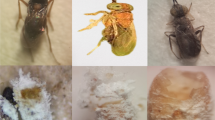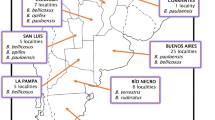Abstract
A maximum number of 6 parasitoid progeny are produced byBrachymeria intermedia (Nees) females, in a 24 h period, even when more than 6 hosts are available. The number of progeny produced by ovipositing females kept at a high temperature or high light intensity is greater than that of females kept at low temperatures or low light intensity. Host size and age of female parasitoids affect the sex ratio or progeny. Parasitism of small pupal hosts results in the production of a greater proportion of male progeny. Increasing maternal age appears to increase the proportion of males.
Résumé
Les femelles deBrachymeria intermedia (Nees) ont un maximum de 6 descendances, sous une photopériode de 24 h, même en présence de plus de 6 hôtes. Le nombre de descendants de femelles maintenues à température élevée (26°C) ou sous une forte intensité lumineuse est plus grand que celui de femelles placées à basse température (15°C) ou sous une faible intensité lumineuse. La taille de l'hôte et l'âge de la femelle du parasitoïde affectent la proportion des sexes ou la fécondité. Le parasitisme de petites chrysalides a pour résultat une proportion plus grande de mâles dans la descendance. L'augmentation de l'âge de la femelle accroît également la proportion de mâles.
Similar content being viewed by others
References
Barbosa, P &Frongillo, E. A. Jr. — 1977. Flight and locomotory responses ofBrachymeria intermedia (Nees) [Hym.: Chalcididae] in various temperatures and light intensities. —Entomophaga, 22, 405–411.
Barbosa, P., Frongillo, E. A., Jr. &Cranshaw, W. — 1978. Orientation of field populations ofBrachymeria intermedia to host and host-habitat cues. —Entomophaga, 23, 63–67.
Dowden, P. B. — 1935.Brachymeria intermedia (Nees), a primary parasite andB. compsilura (Cwfd.) a secondary parasite of the gypsy moth. —J. Agric. Res., 50, 495–523.
Grimble, D. G. — 1975. Dispersal of releasedBrachymeria intermedia. —Appl. For. Inst. Res., Note No. 16, 4 pp.
Grimble, D. G. — 1976. Parasite release to suppress gypsy moth and reduce defoliation. —Appl. For. Res. Inst. Rept., No. 32, 26 pp.
Leonard, D. E., Bierl, B. A. &Beroza, M. — 1975. Gypsy moth kairomones influencing behavior of the parasitoidsBrachymeria intermedia andApanteles melanoscelus. —Environ. Entomol., 4, 929–930.
Minot, M. C. &Leonard, D. E. — 1976a. Effect of temperature, humidity, light and gravity on the parasitoidBrachymeria intermedia. —Environ. Entomol., 5, 427–430.
— 1976. Host preference and development of the parasitoidBrachymeria intermedia inLymantria dispar, Galleria mellonella andChoristoneura fumiferana. —Environ. Entomol., 5, 527–532.
Tucker, J. E. &Leonard, D. E. — 1977. The role of kairomones in host recognition and host acceptance behavior of the parasiteBrachymeria intermedia. —Environ. Entomol., 6, 527–531.
Author information
Authors and Affiliations
Additional information
Paper No. Massachusetts Agricultural Experiment Station, University of Massachusetts at Amherst, MA., U.S.A. This research supported (in part) from Experiment Station Project No. 437 and a U.S.D.A. sponsored program entitled, “The Expanded Gypsy Moth Research and Development Program” (CSRS Special Grant No. 516-15-57).
Rights and permissions
About this article
Cite this article
Barbosa, P., Frongillo, E.A. Host parasitoid interactions affecting reproduction and oviposition byBrachymeria intermedia [Hym.: Chalcididae] . Entomophaga 24, 139–143 (1979). https://doi.org/10.1007/BF02375127
Issue Date:
DOI: https://doi.org/10.1007/BF02375127




